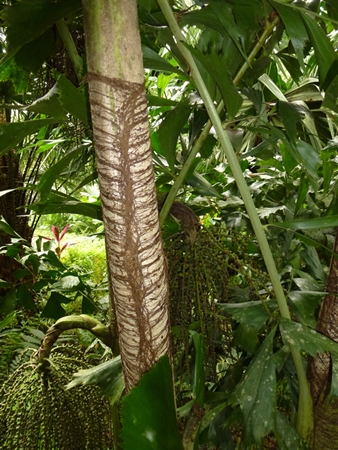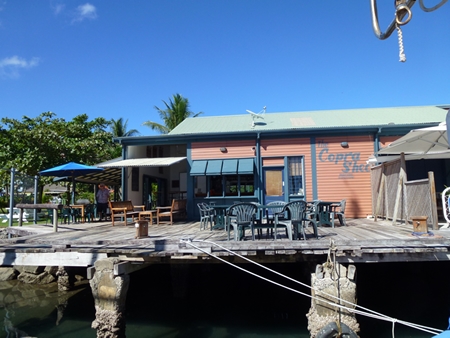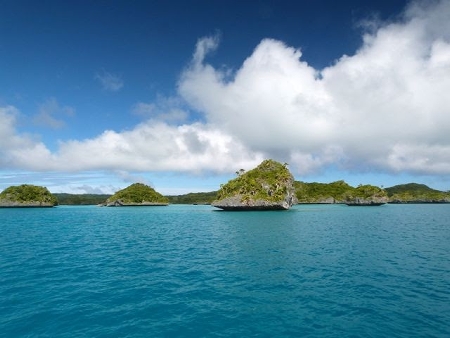Saturday 17th August 2013 - Hassle Across the Anti-meridian - Part 2

|
Saturday 17th August 2013 – Hassle Across the Anti-meridian – Part 2 Continued from Part 1. We did
manage one grockle outing – a visit to Jim Valentine’s Floratropica
gardens. Jim is an ex pat
Australian who settled just outside Savusavu about ten years ago and built up a
small nursery. His passion,
however, is palm trees and he has spent much time researching, travelling the
world and acquiring specimens particularly those that are endangered. He isn’t able to buy everything he would
like as the seeds for some are fabulously expensive - running into thousands of
dollars. The garden he has created
over several acres of hillside is stunning and are definitely worth a
visit. The sheer numbers and
variety of palms is staggering. Jim
takes each group around himself and is a walking encyclopaedia on horticulture
in
Magnificent Traveller’s Palm - misnamed as it is actually a member of the Bird of Paradise family.
The precise cut has not been created by man but a beetle which lived in the leaf bud
Almost as good as Carol’s tail plaiting – horse that is!
A very tough, plastic like leaved palm often used for roofing
Wherever there’s a pond a cat has to keep an eye out for fish!
Well worth the climb to the top of gardens So,
the moment of departure from Savusavu arrived. On Saturday 3rd August the
easterly trade winds had disappeared as the result of a weather system to the
south and we had light northerly winds for a few days. We were heading south-east for 185NM to
get to Fulanga at the southern end of the remote Lau Group. From there we’d use the prevailing
By now we’d missed the weather window and patiently awaited the
next one. It was in the offing and
duly arrived in time for us to do the journey to Falanga starting on the morning
of Sunday 11th August.
The 185NM journey would take us around 31 hours at a reasonably
conservative 6 knots and we needed to arrive off Fulanga at around 1000 hours on
Monday morning to be able to negotiate the pass through the reefs safely. A departure from the creek in Savusavu
at 0300 or earlier did not appeal.
It’s the reef thing. So, on
Saturday afternoon we moved the few miles out to anchor off the Cousteau resort
at the mouth of The journey to Falanga was an uneventful 30 hours of motoring in almost windless conditions. The wind direction wasn’t always helpful but that was preferable to its being strong and on the nose. We arrived off the entrance together with Bob and Linda Hargreaves in Bright Angel. One slight downer was that the domestic battery alternator had ceased charging our domestic batteries on the way but we assumed that to be a regulator problem which we could resolve on arrival with our spare regulator. Pulse rate was slightly up since we had tried but failed to obtain any large scale paper chart of the lagoon. Our two sets of digital charting showed quite different interpretations of reality and the GPS waypoints we had obtained established that neither approximated to the truth unless previous sailors had carried their yachts across islands and anchored on beaches. As we approached the pass through the reef - Bright Angel in the lead – Bob told us that a friend of his was in the pass in his dinghy and would lead us through. It was pedal to the metal aboard Arnamentia as we closed up to Bright Angel’s stern. Once through we followed Bright Angel to the anchorage from which one is required to do the sevusevu bit (kava root, gift wrapped and presented to the local chief and all that). It was good to note that our route took us straight through all the waypoints we had on the chart plotter. So, at least those were kosher. Falanga island is roughly oval in shape and about 5NM by 4NM in size. It comprises a narrow rim surrounding a large lagoon. It is much like a volcanic atoll in that respect. The lagoon has several score – perhaps hundreds - of islands and islets. Depending upon your digital charting either almost none of them are charted or around 20 are but all in the wrong places. So, that’s handy and relaxing for the first time visitor. At least if you have waypoints you can rely upon, whilst you may not know where the dangers are you do know some places they ain’t. But there is still no substitute for eyeball navigation with someone in the bow looking for the ‘bommies’. Had we been able to tarry longer we would, doubtless, have acquired the nonchalance of those who had been there for several weeks by the time we arrived and happily moved Arnamentia about the lagoon to go snorkelling and whatever rather than undertake lengthy dinghy passages. But we
weren’t going to be there for long despite engaging company in the form of Bob
and Linda on Bright Angel, Ding and
Sue on Chiquita, Geza and Eva on Rotor and Jamie and Lucy on Bamboozle. Bob and Linda had already sallied ashore
and done the sevusevu bit by the time that we’d discovered that the alternator
was almost certainly burnt out and the auxiliary generator wasn’t charging its
own battery (although it was delivering AC power to the battery charger). We could just about manage that problem
and the lack of a domestic battery bank alternator provided that we had absolute
confidence that the auxiliary generator would keep producing AC power. Yeah, well. To crown it all, having filled a couple
of water jerry cans from our tanks for Chiquita we discovered that the water
maker was not working. There was no
immediate water crisis but we needed to fix it somehow. Unlike sailors of simpler days - and
some of today of the hair shirt variety - we were simply not set up to survive
long periods without access to water from either shore sources or the
watermaker. And our plan was to be
in the Lau Group for 5 or 6 weeks.
If we were to get serious yottie stuff fixed in Tai – the chief’s son – visited us at the anchorage the following day. Normally this would have been to arrange a time for sevusevu. We explained the situation and begged relief from the formality since we intended to depart the next morning. He was sad that we were leaving but otherwise perfectly happy with that and even happier with the 400 B&H cigarettes we’d been requested to buy in Savusavu and sell to him at cost on arrival, together with 10 leaves of Fijian tobacco. He didn’t query the cost of $7.60 a pack but confided to Ding that whoever sold them to us had probably seen us coming because the cost should have been $5. Since they had been bought in the MH supermarket in Savusavu it is rather more likely that it is some time since Tai actually bought any himself. But the whole world could pass you by in Falanga and gentle government initiatives to discourage smoking certainly could. On the subject of cigarettes, preach as you like but these are hugely treasured and you can apparently buy pretty well anything you like with them. Frequently it is not a full pack that is the accepted price. A good big lobster? That’ll be 6 fags and the lad will probably have smoked the lot before he gets ashore. We also gave Tai around 40 litres of petrol but took the precaution of mixing in the 2 stroke oil first. If you don’t there is a serious danger that they will try to run their 2 stroke outboard ‘motos’ on neat petrol because they generally buy rubbishy ol’ premix stuff and aren’t entirely clear about the difference. Last we gave him a couple of wraps of kava in lieu of sevusevu, a few dollars worth of food staples (the supply boat has not visited for two months now) and every empty plastic and glass container we had aboard (having been collecting these for a few weeks in anticipation). The islanders use them for all manner of things including the bottling of produce they trade through the supply ship. Wednesday morning saw the usual flurry of activity as we prepared to go and ensure that we made the pass at the right time – about midday. As with our arrival, we were leaving at around high water. The slack tide at this event apparently lasts for about an hour and so it’s a relatively stress-free time to exit. In other weeks, of course, the slack you’ll be dealing with during the relatively well lit hours between about 0900 and 1500 will be a low tide. That can be a bit more tricky and if you try to go too early – whilst the lagoon is still emptying – you may have an appreciable standing wave to deal with just outside the entrance. With any luck we’ll find out anon because Falanga is surely a ‘Must do and do properly’. By the
time we departed, the SE Trades had re-established themselves and we flew
downwind under full plain sail. We
even put Hector the Hydrovane in charge of steering to save battery power. There was no hope of getting into Port
Denarau in the dark and without someone around to show us where to berth. So, by 1000 on Thursday we had to slow
down by stowing the mainsail and rolling away most of the yankee. It was still difficult to make under 6
knots. However we eventually
managed it and navigated through the Navula Passage at the SW corner of
That afternoon, Baobab Marine took the auxiliary generator and the alternator into their custody in preparation for work commencing on Monday. We hope to get the watermaker looked at then as well as resolving a persistent VHF reception problem – possibly caused by the new-fangled active AIS. BOATS – break out another thousand! Busy
place, Denarau. It’s a major marina
complex with extensive shopping, bars, restaurants and all that jazz. Not quite what In summary
If you’ve got to spend a good few weeks n Savusavu then there are worse places to be than tied up to the Copra Shed Bar.
In contrast, where we are now in Port Denerau – though to be fair the bunkering vessel isn’t always there so we can get a better view of the slipway and haul out
And Fulanga, where we were for less than 48 hours – enough said! None of these islands is charted, by the way! |








